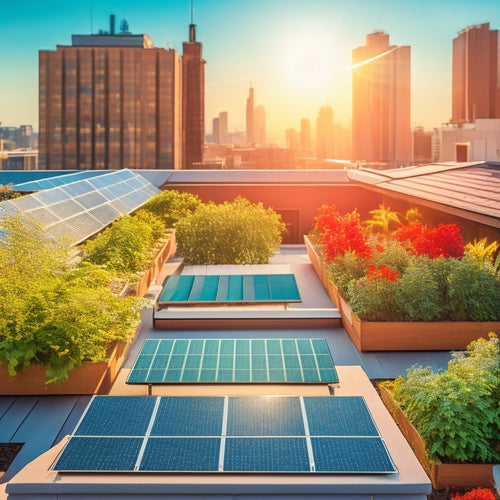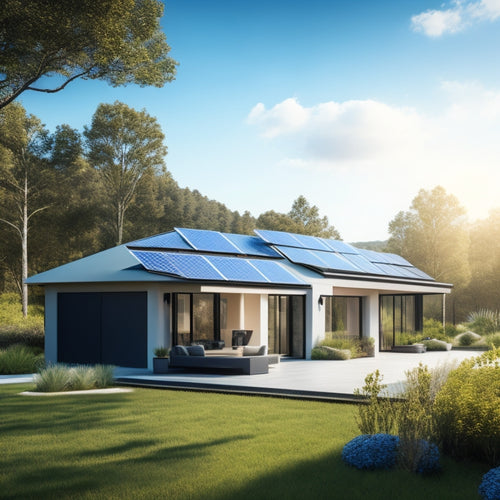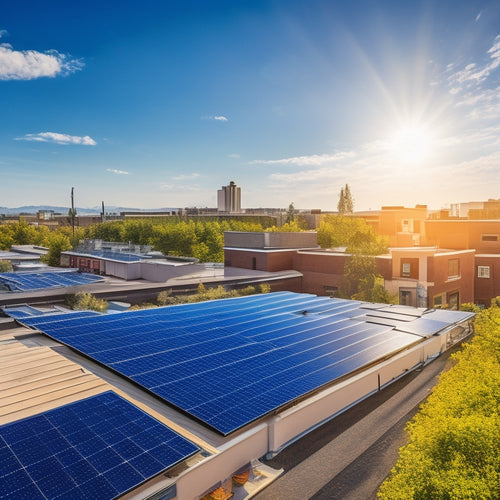
Solar System Costs for Residential and Commercial Use
Share
As you evaluate solar systems for your residential or commercial property, understanding the costs involved is essential for maximizing your return on investment. Residential energy savings typically range from 20% to 50%, making solar an attractive option for homeowners. Commercial systems, on the other hand, are larger and more complex, leading to increased upfront costs. Factors like equipment quality, market demand, and installation complexity impact overall costs. You'll need to examine permits, inspection fees, and maintenance costs as well. Knowing these factors will help you make an informed decision - and there's more to investigate when it comes to incentives, installation techniques, and system design that can optimize your solar investment.
Key Takeaways
- Residential solar systems can save homeowners 20-50% on energy bills and increase property value, with warranties typically guaranteeing performance for at least 25 years.
- Commercial solar systems are larger and more complex, leading to higher upfront costs, but understanding cost factors is crucial for maximizing return on investment.
- Equipment quality, market demand, and technological advancements significantly impact solar system costs, making informed decision-making essential for solar investments.
- Installation fees, including design costs and labor fees, range from $2,000 to $5,000, and inverter and mounting costs add up to $4,000 to $6,000.
- Federal and state incentives, such as tax credits and rebates, can significantly reduce overall costs, making solar energy more accessible for residential and commercial use.
Residential Solar System Pricing
Your residential solar system's pricing is an important aspect to keep in mind when deciding to harness the power of the sun to reduce your energy bills and carbon footprint.
You'll want to reflect on various solar financing options, including lease and purchase agreements, to determine which best suits your budget. With residential energy savings typically ranging from 20% to 50%, understanding the long-term benefits is vital.
Look for solar panel warranties that guarantee performance for at least 25 years, ensuring your investment pays off. Additionally, contemplate the home value impact, as installing solar panels can increase your property's value.
Research neighborhood solar trends to determine if your area is conducive to solar energy. You may also be eligible for tax credits, but be aware of potential property tax implications.
Stay up-to-date with solar technology advancements, which can affect pricing and efficiency. Finally, factor in installation timeline considerations, as this can impact your overall cost.
Commercial Solar System Costs
As you shift your focus from residential solar systems to commercial applications, it's clear that the cost factors change considerably.
Commercial solar systems are typically larger and more complex, requiring more equipment and installation proficiency. This increases the upfront cost, but also provides greater solar energy benefits.
When it comes to commercial solar financing, you'll need to take into account the following:
-
System size and complexity: Larger systems require more equipment and labor, driving up costs.
-
Installation requirements: Commercial buildings often have unique installation requirements, such as rooftop access or electrical infrastructure upgrades.
-
Permitting and inspections: Commercial projects involve more permits, inspections, and compliance requirements, adding to the overall cost.
To maximize your return on investment, it's crucial to understand these cost factors and work with a reputable installer who can guide you through the process.
Factors Affecting Solar Costs
The solar panel installation environment is dotted with various factors that influence the overall cost of a commercial solar system. As you consider investing in solar technology, it's crucial to understand these factors to make an informed decision.
Solar technology advancements have greatly reduced costs over the years. However, market demand fluctuations can cause prices to vary. Additionally, the type and quality of equipment used, such as high-efficiency panels or inverters, can impact the overall cost.
Here's a breakdown of how these factors affect solar costs:
| Factor | Impact on Cost | Description |
|---|---|---|
| Equipment Quality | High | High-efficiency panels and premium inverters increase costs |
| Market Demand | Medium | Fluctuations in demand affect prices of solar panels and components |
| Solar Technology Advancements | Low | Continuous innovations drive down costs over time |
Understanding these factors will help you traverse the complex terrain of solar system costs and make informed decisions for your commercial solar project.
Solar Panel Installation Fees
When you're evaluating solar panel installation fees, you'll need to take into account system design costs, which include the time and skill required to customize a system that meets your energy needs and accommodates your roof's unique characteristics.
Labor installation fees, on the other hand, cover the cost of actually installing the system, including the wages of the installation team and any necessary permits or inspections.
System Design Costs
You're likely to spend a significant portion of your solar system budget on system design costs, which encompass the fees associated with designing and installing your solar panel system.
These costs can vary depending on the complexity of your project, the size of your system, and the proficiency of your installer.
System design considerations include evaluating your energy needs, assessing your site's solar potential, and selecting the appropriate equipment for your system.
To streamline this process, installers use system design software to create a customized plan for your solar panel installation.
This software takes into account factors such as:
- Roof size and layout: Ensuring a safe and efficient installation.
- Shading and obstruction analysis: Identifying potential energy losses due to trees, buildings, or other obstructions.
- Energy usage patterns: Optimizing your system to meet your specific energy needs.
Labor Installation Fees
Labor Installation Fees (Solar Panel Installation Fees)
When you're investing in a solar system, you're not just paying for the equipment - you're also paying for the skill to install it correctly. Labor installation fees, also known as solar panel installation fees, vary depending on your location and the labor market. In areas with a high demand for solar installations, you may pay a premium for skilled labor.
The installation techniques used by the contractor also impact the labor cost. For example, if you have a complex roofline or require specialized mounting systems, the installation may require more time and skill, increasing the labor cost.
On average, labor installation fees range from $2,000 to $5,000 for a residential solar system, depending on the system size and complexity.
As you research solar installers, ask about their labor installation fees and what's included in the cost. Be wary of extremely low bids, as they may indicate inexperience or a lack of necessary licenses and certifications.
Inverters and Mounting Costs
Most solar panel systems require at least one inverter to convert the DC power generated by the panels into AC power that's usable in your home.
You'll need to take into account the type of inverter suitable for your system, as there are string inverters, microinverters, and power optimizers. Each has its pros and cons, affecting the overall cost and efficiency of your solar system.
When it comes to mounting your solar panels, the materials you choose will also impact the cost.
You'll need to decide on:
- Racking and tracking systems: These can be fixed or adjustable, and may include features like single-axis or dual-axis tracking to maximize energy output.
- Mounting hardware: This includes clamps, brackets, and fasteners that secure the panels to your roof or ground-mounted system.
- Structural components: These can include roof anchors, flashing, and other components that guarantee a secure and weather-tight installation.
The cost of inverters and mounting materials can vary widely, depending on the quality, brand, and features you choose.
On average, you can expect to pay between $1,500 and $3,000 for a high-quality inverter, and $1,000 to $2,000 for mounting materials, depending on the size of your system.
Energy Storage System Prices
You'll need to take into account the system configuration costs, which include the expense of designing and integrating the energy storage system with your solar panel array and inverter.
The battery unit pricing will also play a significant role in determining the overall cost of your energy storage system, with prices varying depending on the type, capacity, and brand of batteries you choose.
System Configuration Costs
Your energy storage system's configuration plays an important role in determining the overall cost of your solar power setup. The way you design and set up your system can greatly impact its efficiency and, ultimately, your energy savings.
When it comes to system configuration costs, you'll need to take into account the following factors:
-
System efficiency: A more efficient system will require fewer components, reducing overall costs. Look for systems with high efficiency ratings to maximize your energy output.
-
System size and complexity: Larger systems or those with more complex configurations will require more components, increasing costs. Be sure to assess your energy needs accurately to avoid oversizing your system.
-
Financing options: Investigate financing options that can help offset the upfront costs of your system configuration. Some financing plans may offer more favorable terms for certain system configurations, so it's important to research and compare your options carefully.
Battery Unit Pricing
The cost of a battery unit, a critical component of an energy storage system, can vary considerably depending on several factors, including the type and quality of the battery, its capacity, and the manufacturer.
You'll find that lead-acid batteries are generally more affordable, with prices ranging from $0.10 to $0.30 per watt-hour. However, lithium-ion batteries, which offer higher energy density and longer lifetimes, can cost between $0.30 and $0.60 per watt-hour.
As you investigate different battery options, consider the impact of battery technology advancements on pricing. Advancements in manufacturing and design have driven down costs, making energy storage more accessible.
Additionally, look into battery recycling options, which can help reduce waste and minimize environmental impact. When evaluating battery unit pricing, also consider the overall system configuration, including the inverter and installation costs.
Permits and Inspection Fees
In conjunction with local authorities, homeowners must secure permits and licenses before commencing their solar system installation, incurring costs that vary depending on the jurisdiction and type of permit required.
You'll need to maneuver the complex web of local regulations, zoning laws, and compliance standards to guarantee your solar system meets the necessary requirements.
Here are three key factors to take into account when applying for permits and undergoing inspections:
-
Permit application and timelines: You'll need to submit your permit application, which may take several weeks or even months to process, depending on the jurisdiction. Be prepared to provide detailed plans and specifications for your solar system.
-
Inspection requirements and processes: Once your permit is approved, you'll need to schedule inspections with local authorities to verify your solar system meets the necessary compliance standards. This may involve multiple inspections, each with its own set of requirements and fees.
-
Fee structures and costs: Permit application fees, inspection fees, and other associated costs can add up quickly. Be sure to factor these expenses into your overall budget, as they can vary greatly depending on your location and type of permit required.
Solar System Maintenance Costs
Optimize your solar system's performance by staying on top of regular maintenance, as neglecting upkeep can lead to reduced energy output, safety hazards, and even system failure.
Regular solar panel cleaning is essential to guarantee maximum energy production. Dirt, dust, and debris can reduce your system's efficiency by up to 25%. You should clean your solar panels every 6-12 months, depending on your location and climate.
Create a maintenance schedule to track and perform routine checks on your system's electrical connections, inverters, and mounting structures. Check for signs of wear and tear, corrosion, or damage, and address any issues promptly.
A well-maintained system won't only generate more power but also extend its lifespan. Expect to pay around $100-$300 per year for routine maintenance, depending on the size and complexity of your system.
Federal and State Incentives
You've taken steps to guarantee your solar system operates at peak performance through regular maintenance.
Now, it's time to investigate the financial benefits available to you. The federal government and individual states offer various incentives to encourage the adoption of renewable energy sources like solar power.
These incentives can greatly reduce the overall cost of your solar system, making it a more attractive investment.
Here are three key benefits:
-
Tax Credits: The federal government provides a tax credit of up to 30% of the total system cost, allowing you to claim a considerable portion of your investment as a credit on your taxes.
-
State Rebates: Many states offer rebates or cash incentives for residential and commercial solar installations, providing additional financial benefits.
-
Financial Incentives: Solar leasing and power purchase agreements can provide grid independence while minimizing upfront costs, offering a lower barrier to entry for those looking to switch to renewable energy.
Frequently Asked Questions
Can I Install Solar Panels on a Rented Property?
You'll typically need tenant permissions before installing solar panels on a rented property, and a solar lease can be a viable option, allowing you to capture renewable energy while ensuring the property owner's interests are protected.
Do Solar Panels Work During Power Outages?
When the grid goes down, you'll still have power if you've invested in a solar panel system with backup systems, achieving grid independence, but without a battery or generator, you won't have electricity during outages.
Can I Use Solar Panels for Heating My Pool?
As you plunge into the serene waters of your pool, imagine utilizing the sun's energy to warm it up; with solar pool systems, you can enhance pool heating efficiency by up to 50%, saving you energy and money while extending your swimming season.
Are Solar Panels Resistant to Hail and Extreme Weather?
You'll be relieved to know that solar panels are designed to withstand harsh weather conditions, boasting impressive hail resistance and weather durability, with tempered glass and sturdy frames that can tolerate extreme winds and precipitation.
Can I Finance My Solar System Through a Home Equity Loan?
You can finance your solar system through a home equity loan, leveraging your property's value to access funding, and reap loan benefits like tax-deductible interest and lower financing options, making your solar investments more affordable and efficient.
Conclusion
As you weigh the benefits of going solar, you're likely wondering: can I afford it? The answer lies in understanding the complex pricing structure of solar systems. From residential installations to commercial projects, various factors influence the final cost. By grasping the breakdown of expenses, from panels to permits, you'll be better equipped to make an informed decision. So, are you ready to tap into the power of the sun and start saving?
Related Posts
-

Solar System Installation Rebates and Tax Credits
Solar system installations offer beneficial rebates and tax credits that greatly cut your initial costs. You can bene...
-

Eco-Friendly Energy Storage Systems for Houses
Eco-friendly energy storage systems for your house let you capture and use renewable energy efficiently. You can choo...
-

Solar Energy Solutions for Small Businesses
Switching to solar energy can be a game changer for your small business. You'll enjoy significant cost savings on mon...


